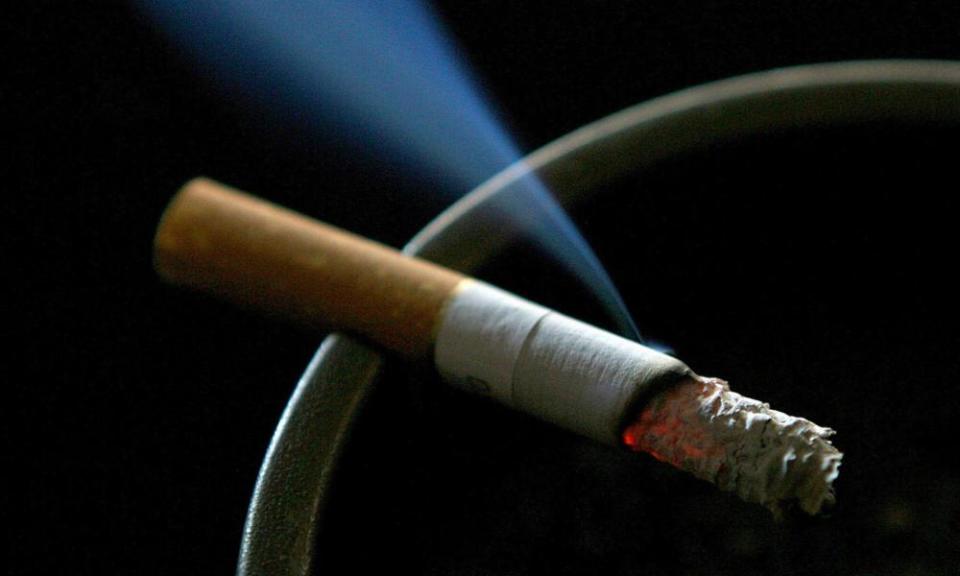Smoking causes half of Indigenous Australian deaths over 45, study shows

Smoking-related illnesses cause half of all deaths of Aboriginal and Torres Strait Islander peoples over the age of 45, accounting for 10,000 premature preventable deaths in the past decade alone, a new study has found.
On average, Aboriginal and Torres Strait Islander people who smoked died 10 years earlier than non-smokers.
The study, published in the International Journal of Epidemiology on Monday, is the first population-specific study to analyse smoking mortality rates in Aboriginal and Torres Strait Islander peoples.
Led by researchers from the Australian National University, it pulled data from 1,388 Aboriginal people from New South Wales who participated in the 45 and up study, a longitudinal study run by the Sax Institute of 267,153 people aged 45 and older who were randomly selected from the NSW population.
Related: The Indigenous health 'gap' is a too benign term for a shattering reality | Ranjana Srivastava
Lead author on the paper Dr Katie Thurbur said the smoking mortality study focused on Aboriginal people who had not, at the time of joining the 45 and up study between 2006 and 2009, been diagnosed with cardiovascular disease or cancer. It then tracked their health outcomes over the next 10 years.
By 2019, 162 of the participants had died. The study found that people who had never smoked lived on average 10 years longer than people who were currently smoking. People who quit before the age of 45 had a risk of death similar to that of people who had never smoked, and half that of people who quit between the age of 45 and 54.
A previous study in 2013 estimated that smoking caused 20% of all deaths of Aboriginal and Torres Strait Islander people, using mortality estimates based on international studies. The population-specific study showed that smoking causes 37% of all deaths of Aboriginal and Torres Strait Islander people, increasing to about half of all deaths of those aged 45 and over.
“It’s close to double what the previous estimates were,” Thurbur said.
Smoking increases the risk of cardiovascular disease and a range of cancers, which are the two leading causes of deaths for Aboriginal and Torres Strait Islander peoples. A study in 2018 found that Indigenous people in Australia were 10% more likely to get cancer than non-Indigenous people.
Thurbur said the study demonstrated both the importance of having population-specific data and the need to invest more in anti-smoking programs specifically tailored to Aboriginal and Torres Strait Islander communities.
“If there was a disease that was responsible for one third of all deaths in a population we would certainly be doing everything we could to prevent that,” she said.
About 40% of all Aboriginal and Torres Strait Islander adults self-identified as smokers in 2019, down from 54.5% in 1994.
ANU associate professor Raymond Lovett, a co-author on the study and Ngiyampaa man, said high rates of smoking stemmed from colonial practices of paying Aboriginal and Torres Strait Islander workers in rations, which included tobacco. That practice did not end until the 1970s.
“If you worked, particularly in rural areas, you were paid in tobacco. That has got a large part to play in why smoking rates are so high,” he said.
While demographic factors of lower incomes and high unemployment also contributed to high smoking rates among some Aboriginal populations, Lovett said it did not account for all the difference. Aboriginal and Torres Strait Islander peoples with a tertiary education and a higher income were less likely to smoke, but more likely to smoke than non-Indigenous people of the same demographic.
He said modern-day health impacts cannot be separated from that colonial legacy.
“My view is you can’t [separate it],” Lovett said. “And it actually becomes a source of a call to action in community-controlled health services and different communities. The way we talk about tobacco as a colonial process, linking tobacco to those colonial processes, because some people have forgotten about that, particularly young people.
“I have seen it … where people are using those colonial process as an intervention to say: this is colonial resistance, this is a part of colonisation and we don’t want this in our community.”
Lovett said that Indigenous-specific health responses, like the tackling Indigenous smoking program, should be boosted in response to this research.
Related: Indigenous health: a third of disease is preventable, says study
“You would think that a good response to this would be to increase resources commensurate with the level of risk that we now understand this poses to people’s lives,” he said.
Prof Tom Calma, also a co-author of the study and national coordinator of the tackling Indigenous smoking program, said “if smoking is a bigger problem than we thought, then funding should be increased to match the size of the problem”.
Lovett also stressed that 80% of people who quit smoking did so cold turkey, without medical intervention.
“Sometimes we medicalise tobacco control to such an extent that people think they can’t do it, they can’t stop or quit, alone,” he said. “Part of our suite of education is to say actually the majority of people quit unassisted.”

 Yahoo Finance
Yahoo Finance 